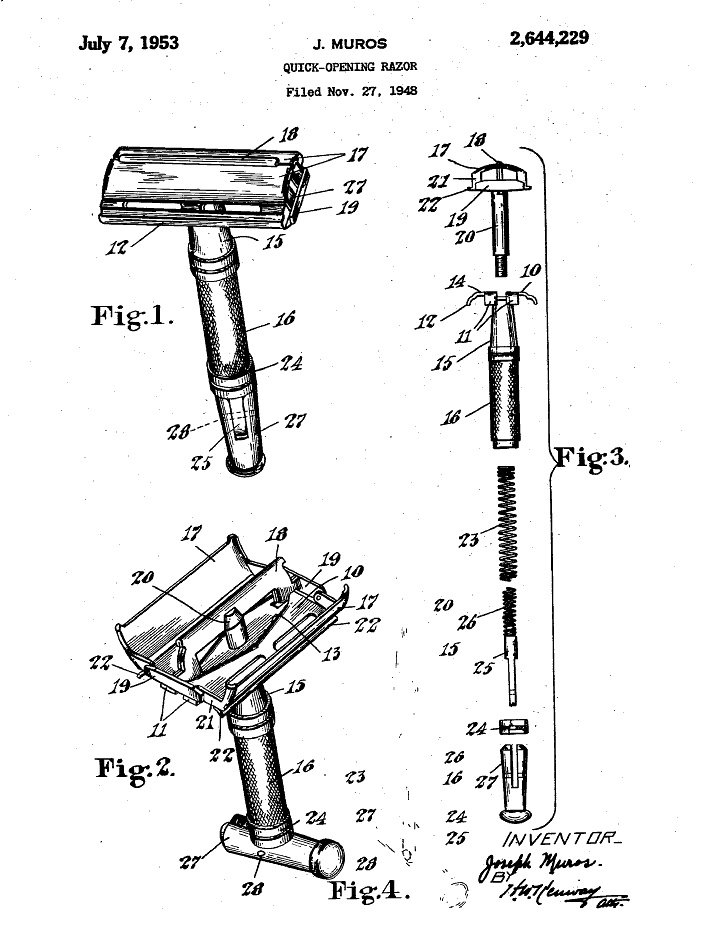Gillette Toggle Adjustable Razor
I suppose that first should come the bit of history, so I’ll just quickly recap: The toggle is the first of the Gillette adjustable razors and was made with limited distribution in 1957 and 1958, and national distribution in 1960. There are 5 adjustment position Toggles (those with serial numbres), and 9 position ones (with D and F codes) in gold (D1 and F4) and a chrome one (F4). The one I’ve been shaving with is a 1958 D1.
When the Toggle came out Ed Sullivan and Jack Benny were on TV, and Bonanza was in the works. That year, 1958, saw the creation of NASA, the indictment into the Army of Elvis Presley, Eisenhower signing the statehood of Alaska, the Wham-O company introducing the Hula Hoop, and the invention of the microchip. Most personally, 1958 conjures this image …
… the ’58 vette our our neighbors at the time had. We moved around in a huge Chrysler though. Those were the times the Toggle saw, and I like to get to know a bit of the history behind my razors, it gives them an add value, son I’ve tried to trace the evolution in designs that led to the Toggle Adjustable. To make the story short, for the longest time Gillette had a couple of key concepts in their heads as to how their razors should be. The idea was ease and safety of use, and adjustability.
Gillette wanted to do away with loose parts in razors and make them easy to handle. They also made their razors mild, paying attention on the safety part of the word safety razor. So Gillette favored comfort and safety, and a razor that nicks you easily was not a good idea in their book. Remember that these razors were made for the general public, and not forum dwelling wet shaving enthusiasts with great soaps and fine tuned shaving technique. And since we are all different and even our face is not always the same, a razor that could vary its shaving characteristics sounds really good.
The first and last important step in the ease of use department was taken by Gillette in 1934, with the introduction of the Aristocrat TTO …
The single piece razor, with the twist-to-open system meant that there was no need to fiddle with parts and a very sharp blade. Up to now adjust-ability is its razors was limited to loosening the head / handle assembly. Although simple, this method does not assure a secure locking of the blade which is a sure recipe for a poor shave. As early as 1907 Gillette was trying to address this problem:
Adjust-ability by virtue of the flexing of the guard while maintaining a tight head assembly
The earliest true adjustable design by Gillette came about in 1936, just two years after the introduction of the Twist to Open concept. Naturally it combined TTO with adjust-ability:
Curiously, as late as 1960, they kept the same 1907 concept of guard flex in mind for this TTO design.
Ok, this is TTO, but what about the Toggle? Well, the earliest Gillette idea of a lever activated razor came about 3 years prior to the introduction of the TTO … 1931.
It doesn’t look like a great design, but it is a start, and may very well have served as an inspiration for the Toggle as we know it, if the lever idea is combined with the butterfly doors of the TTO’s. And sure enough, a non adjustable toggle pops out of the head of Gillette designers.
This non adjustable toggle idea predates the actual Toggles by 10 years, and never saw the light, although I keep thinking that somewhere there is a drawer or a box full of crazy Gillette prototypes awaiting discovery … and then adjust-ability was thrown in … An adjustable Toggle with 3 distinct Toggle positions: Closed, rinsing, and open. Interestingly, this 1955 Toggle design had the same head adjustment mechanism as the regular Fatboys and Slims
… and in 1957 the “turret” type adjustable head that the final Toggles sported …
So we can see that Gillette toyed for a long time with several ideas around 3 basic concepts, ease of use, safe operation, and adjust-ability. The resulting Toggle that was finally marketed was unique, not only for the toggle mechanism, but for its turret type head. The head of the Toggle (and few other short lived Gillette adjustables) fixes the blade in position and the adjustment is carried by modifying the gap and only the gap. The later to come Fatboy and Slims work in a slightly different manner, and as the gap is opened there is also an increase of the blade’s cutting angle.
Is there any difference between both types of heads? I believe there is. Regular Fatboys and Slims, and because they vary the blade cutting angle as well as the gap as it is adjusted, tend to have a sweet spot were they offer good qualities; up or below that spot, the quality of the shave diminishes. Adjusting these razors towards the minimum provides a small gap paired with a small cutting angle. Both factors contribute to a mild shave. Conversely, adjusting it towards the maximum increases the gap as well as the cutting angle. Both factors contribute to a harsher shave. Theoretically it should be the opposite. To maintain smooth shave characteristics, as you increase the gap, the cutting angle should be proportionately decreased, and vice-versa. There is no adjustable that is able to do this, in fact there is only one non-adjustable razor head I know of that behaves this way … the slant. Take a careful look at it and you will find that as gap increases the blade cutting angle decreases. This is one of the various reasons the slant can be so smooth. At least turret type adjustables manage to maintain one of the factors constant, and therefore the shaving personality of the razor is more homogeneous throughout the adjust-ability range. Is it a big difference? No, not really, but it definitely can be felt if you pay attention. So enough with the theory
The Toggle comes in a nice methacrylate case. From pictures it may just look like a plastic case but it is surprisingly good. It ‘is quite heavy and with the Gillette name and emblem in three dimensions, not just print but golden tone 3D. Pictures don’t bring out this very well, but is is no ordinary case.
Inside, the razor seats on a synthetic velvet platform. Again, instead of the usual flimsy form fitted plastic that pictures may convey it is quite solid as it serves a dual purpose: Presentation in the case and a convenient travel case.
The razor weights in at 90 grams (3.1 oz) and is gold plated and lacquer protected, giving it a warmer and darker gold tone than other gold plated Gillettes. Function is pretty straight forward: flick the toggle lever halfway and the head unit loosens without opening. Supposedly this is intended for rinsing. Move the lever further and the head pops open. It is spring assisted, so it literally pops open.
What really gets my attention in operation is the tolerances. Unlike the Fatboys and Slims, there is absolutely no free play, slack, or looseness to any of the parts. This razor is just tight. Be it the toggle lever, the adjustment ring, or the silo doors, all are really tight. Knurling is delicate and very well executed, and finish is immaculate.
Usually I adapt fairly quick to most any razor, and I don’t know why, but it took me a couple of shaves to get the best out of this razor. Once there, I believe the Toggle is a fine shaver. It is, as most Gillette’s are, in the mild side of the spectrum. In fact, settings 1 and 2 are just useless, and although the aggressiveness change from setting to setting is very small, once it reaches the higher numbers it can shave with ease a 2 day beard.
Had some problems thinking up this review. This razor causes some mixed feelings in me. I find it gorgeous but at the same time I just can’t completely come to terms with it. I find some razors all around just great … let’s say … some of the British Aristocrats: they shave me very well, they are very well built and finished, and aesthetically quite attractive. I just can’t ask for more in a razor.
As for the Toggle, it is exceptionally well built. Tolerances are the best I have seen in any TTO (have yet to get my hands on a bottom dial Fatboy), and finish is at the same level … a (big) step above any Slim or Fatboy. Its shave is also smooth in a typically Gillette way. So, what’s with it that leaves me kind of cold? Probably it is its price and reputation. For just plain shaving I don’t think it is justified. A whole lot of razors will shave you just the same, or even better, for a fraction of the price. This mint Toggle cost me the price of a Futur, so it was a no brainer, but I get kind of dizzy seeing the prices, even user grade Toggles, command in internet. For the price I would expect the razor to even make coffee for me in the morning! So if your are considering a Toggle just for its shaves I would sincerely recommend to forget about it. Prices are sky high, but shaves are – as all razors – at ground level. If you are a serious collector, then there is no argument … most probably you have started your hunt already. If you are in between, not a serious collector but you like to have a number of good quality razors in your nook with some history and personality behind them, then you’ll be left pondering the is it worth it question. It becomes then something very personal, and I just can’t offer more help than writing this post. Anyhow, I am just enthused with this gorgeous razor.
This article was written by Tony of The Shave Nook.




















